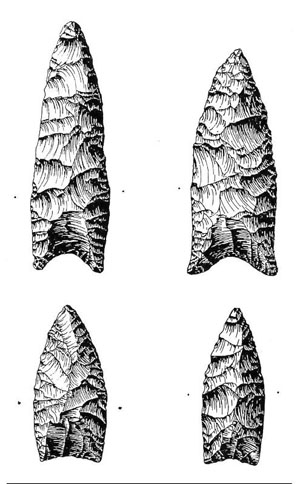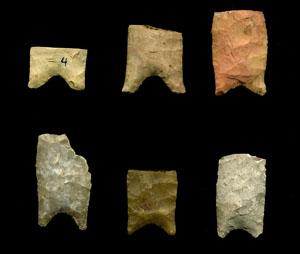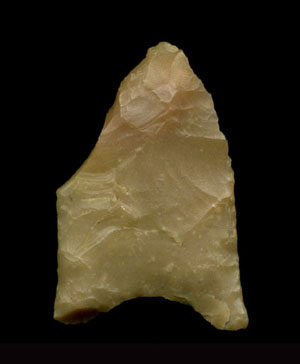Golondrina Expansion
The most common spear or dart point linked to the Paleoindian era in the South Texas Plains is the Golondrina point, so-named because its deep basal notch and usual flaring basal “ears” look something like a the split tail of a swallow (golondrina in Spanish). Golondrina points are widespread across much of central and northern part of the region, although their distribution extends northward along the Balcones Escarpment well into north-central Texas. Yet, Golondrina points are so common across the South Texas Plains that they can be said to represent a population expansion, the first distinctive regional cultural pattern in the area. The Golondrina Complex dates to Late Paleoindian times, about 10,000 years ago (8,000 B.C.) or somewhat earlier.
Unfortunately, most Golondrina points found in the South Texas Plains are found on the surface, often in mixed collections with artifacts from later periods. Thus far, a buried Golondrina site with a full range of associated finds has yet to be found and excavated in south Texas. Fortunately, several very informative sites have been found nearby in the Lower Pecos Canyonlands and in Nuevo Leon in northeastern Mexico.
The distinctive points were first recognized in 1964 during excavations at the Devil’s Mouth site in what is today Amistad Reservoir near Del Rio (see Before Amistad). These points were lanceolate in outline and shared many similarities with the Plainview point type, except they had outward-flaring basal corners (ears). LeRoy Johnson, Jr., the excavator of Devil’s Mouth, called them Plainview golondrina. A few years later, Professor J. F. Epstein published a report on the San Isidro site in Nuevo Leon in northeastern Mexico, less than 80 miles southeast of the Rio Grande. Basically a surface site, San Isidro yielded 14 Golondrina points along with bifacial adzes (Clear Fork tools) in apparent association. Epstein attributed the points, much as Johnson had, to Plainview times.
Finally, in excavations in 1970 and 1976 at Baker Cave – not far from Devil’s Mouth in the Lower Pecos Canyonlands– stratified components containing Golondrina points were found in a context that provided a much broader view of this cultural pattern. Several radiocarbon ages of around 8,000 B.C. were obtained there as well as a bifacial Clear Fork tool with plant residues on its bit, trimmed blades, and other stone tools. Most informative was a cooking pit that yielded a tremendous amount of information on Golondrina Complex diet. Charred plant remains included walnut, persimmon, hackberry, mesquite, acorns, Opuntia and many other species of seeds and nuts. Only small mammals were found in the hearth, including including rabbit, squirrel, rat, gopher, mice, and fox. There were also fish, especially sucker or carp, bass, and sunfish. Most surprising, however, was the diversity of reptiles which consisted of at least 16 different species of snakes (ratsnake, racer, bullsnake, rattlesnake, kingsnake, and others).
This diverse suite of plants and animals showed that the peoples who used Golondrina points were intensive foragers who relied on edible resources from many different ecological niches. While we still do not know many other details about the Golondrina Complex, it is the earliest cultural pattern that seems to represent a specific adaptation to the semi-arid landscape of the South Texas Plains. Gone were the days of the Clovis and Folsom “big game hunters” preying on Ice Age animals. The South Texas Plains had become the homeland of small groups of hunters and gatherers, as it would remain through the succeeding millennia of the prehistoric era.
Contributed by Thomas R. Hester
Sources
M. F. Chadderon,
1983 Baker Cave, Val Verde County, Texas: the 1976 Excavations.San Antonio
J. F. Epstein,
1969 The San Isidro Site, an Early Man Campsite in Nuevo Leon, Mexico.
Austin .
Hester, T. R.,
1983 Late Paleo-Indian Occupations at Baker Cave, Southwestern Texas. Bulletin of the Texas
Archeological Society 53: 101-120.
L. Johnson, Jr.,
1964 The Devil’s Mouth Site, A Stratified Campsite at Amistad Reservoir, Val Verde County, Texas.Austin.
Word, J. H., and C. L. Douglas,
1970 Excavations at Baker Cave, Val Verde County, Texas. Bulletin No. 16. Texas Memorial Museum, Austin.


